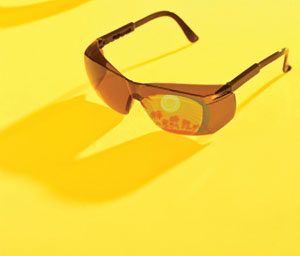BY JETAL PATEL, O.D.
 According to the Centers for Disease Control and Prevention (CDC), skin cancer is the most common form of cancer in the United States, and about 65 to 90 percent of melanomas are caused by ultraviolet rays. We know the importance of protecting our skin from these harmful ultraviolet (UV) rays, but protecting our eyes and the sensitive skin around our eyes is equally important.
According to the Centers for Disease Control and Prevention (CDC), skin cancer is the most common form of cancer in the United States, and about 65 to 90 percent of melanomas are caused by ultraviolet rays. We know the importance of protecting our skin from these harmful ultraviolet (UV) rays, but protecting our eyes and the sensitive skin around our eyes is equally important.
Ultraviolet rays are an invisible form of radiation emitted from the sun, tanning beds, welding machines, lasers, and sunlamps. The three types of UV rays are ultraviolet A (UVA), ultraviolet B (UVB), and ultraviolet C (UVC).
• UVA is the most common kind of radiation at the earth’s surface. UVA rays can pass through the cornea and reach the lens and retina inside the eye.
• Most UVB rays are absorbed by the ozone layer, so they are less common at the earth’s surface than UVA rays. UVB rays don’t reach as far into the skin as UVA rays, but they can still be damaging. UVB radiation stimulates the production of melanin (a skin pigment), causing the skin to darken, creating a
suntan. But in higher doses, UVB
rays cause sunburn that increases the risk of skin cancer. UVB rays also cause skin discolorations, wrinkles, and other signs of
premature aging of the skin.
• UVC rays are very dangerous, but they are absorbed by the ozone layer and do not reach the earth’s surface.
Extended exposure to UV rays has been linked to eye conditions such as cataracts, macular degeneration, pingueculae, pterygium, and photokeratitis. Too much exposure to UV rays can also change skin elasticity, cause premature aging, and can lead to skin cancer. The most common malignant tumor of the eyelid is basal cell carcinoma. Solar keratosis is another condition directly related to excessive solar/UV radiation. First symptoms usually include a dry scaly lesion which can proceed to malignancy as a squamous cell carcinoma. For prevention, The American Optometric Association recommends the use of quality sunglasses and a wide brimmed hat when outdoors.
Shopping for shades
Sunglasses are not just an accessory to our sense of style but, more importantly, a necessity to protect our eyes. When selecting a frame, look for wrap-around styles if you plan on being outdoors for extended periods of time. The lenses should block 99 to 100 percent of UV light. Polarized lenses are very beneficial around water or other reflective surfaces, as they can reduce glare and provide clearer vision. UV levels are greater when highly reflective surfaces are present, like snow and sand. In fact, UV exposure can nearly double when UV rays are reflected from the snow and are greater at higher altitudes, making sunglasses crucial when skiing. It’s also important to protect your eyes even in the shade, as UV light can reflect off surrounding buildings.
Kids need eye protection too
It is also important to protect children early on from harmful solar radiation, as they tend to spend more time playing outdoors, and the harmful effects tend to add up during an individual’s lifetime. Polycarbonate lenses, which are impact-resistant, are strongly recommended for children because they also protect their eyes from injuries.
Ultraviolet rays may be invisible, but the long-term effects of overexposure are very visible. In order to reduce your risks, remember to protect your skin with sunscreen and your eyes with quality sunglasses.






